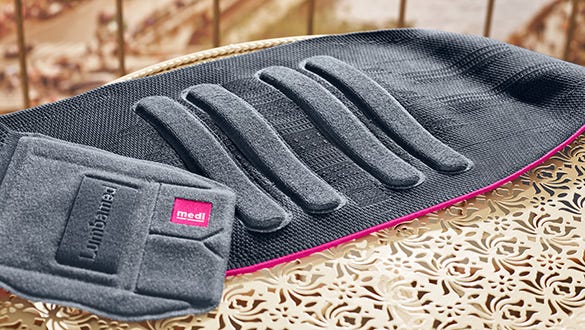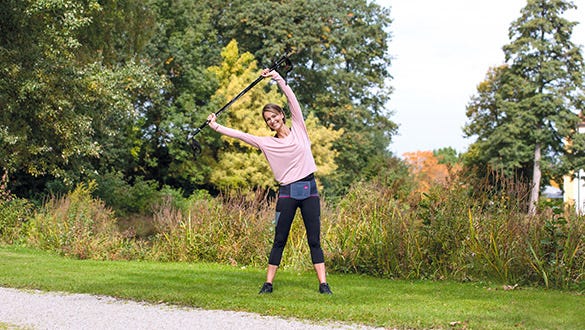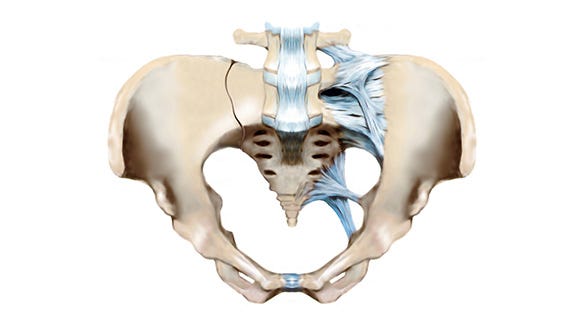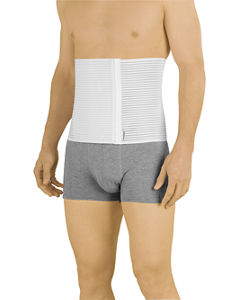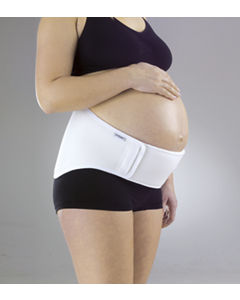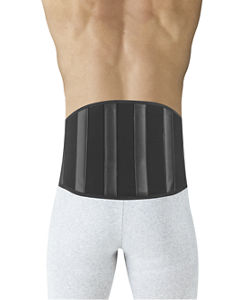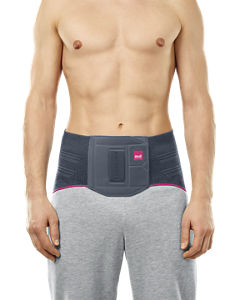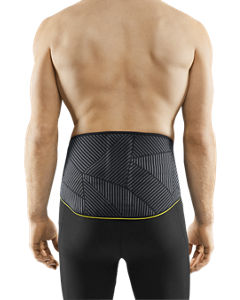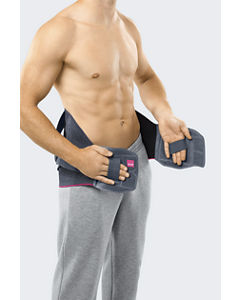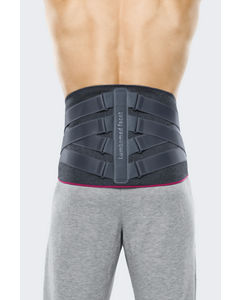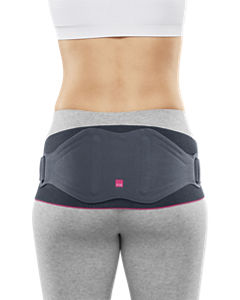- Free First Class Delivery
- Buyer Protection
- Secure Online Shopping
- Healthcare Professional? Click here
Back pain


Categories
No matter whether the cause is a pinched sciatic nerve, lumbago, a slipped disc or muscular tension, back pain can be truly incapacitating.
What can you do about back pain?
Back pain accounts for the highest number of days off sick and is the number one health complaint in the UK.
In most cases, overworked muscles and ligaments or an overloaded spine is the cause. The good news: back problems often disappear spontaneously within three months. But sometimes we can also help recovery along a little – with physiotherapy or supports, for example. They feel really good and help the back to recuperate. You are fit again more quickly and can resume your normal day-to-day activities.
Types of back pain
The spinal column is one of the load-bearing elements in the human body. It is made up of 24 vertebrae, which are connected by intervertebral discs that permit them to move relative to one another. The sacrum and finally the coccyx form the end of the spine.
Pain can develop in any one or all three of the sections of the spine - the cervical (neck), the thoracic and the lumbar spine. Back pain is caused by diseases or injuries of the discs (for example, a prolapsed intervertebral disc) or joints between the vertebrae (for example, wear and tear, so-called "osteoarthritis of the facet joints") or by other conditions.
Back pain has advanced over the last years and decades to become the No. 1 widespread condition. Dr Holger Eggers, specialist for orthopaedics/accident surgery at the MedCenter in Bayreuth, talks about the subject of back pain and explains the need for medical treatment, if it persists.
The spinal column
While the dorsal spine is rarely affected, about one third of all cases of spinal pain affect the cervical spine. Around two thirds of the patients have symptoms in the lumbar spine – this is known as "low back pain" or often colloquially as lumbago.
This lower section of the spine is more exposed to heavy stresses than anywhere else, among other things due to the fact that we walk upright or lift heavy objects with our backs bent.
"Acute" back pain usually lasts for up to six weeks. If it continues beyond this period for up to 12 weeks it is called "subacute", while back pain that still persists after 12 weeks is called "chronic back pain".
We generally distinguish between the following types of back pain:
Depending on whether unequivocal physical causes and findings are present or whether there are no clearly recognisable causes, we distinguish between
- non-specific back pain and
- specific back pain
Dr Holger Eggers, specialist for orthopaedics/accident surgery at the MedCenter in Bayreuth, talks about specific, non-specific and chronic back pain.
Non-specific and specific back pain
Non-specific back pain
Most cases can be allocated to the category of non-specific back pain. Here the exact cause of the pain cannot be diagnosed.
Dr Holger Eggers, specialist for orthopaedics/accident surgery at the MedCenter in Bayreuth, explains the effects of postural problems and too little physical exercise on the human back.
Specific back pain
If the exact cause of the pain is known, we talk about specific back pain.
This is caused, for instance, by injuries, intervertebral disc disease, inflammation or wear and tear of the joints between the vertebrae (so-called "osteoarthritis of the facet joints").
Symptoms and complaints
Almost everybody has experienced a "jab" or slight pain in the back. "It's my back again" is a phrase we often hear and our backs put up with a lot of stress every day. Hours spent sitting in the office, slumped posture in front of the PC, heavy lifting and carrying or bending down doing the gardening: a little back pain is part and parcel of daily life.
If the symptoms last longer, they should be taken more seriously. Do certain movements hurt? Does the pain radiate into the arms or legs, do you have a feeling of numbness? For example, while a prolapsed disc can cause agonising pain that radiates into a leg, wear and tear of the joints between the vertebrae is felt more as a dull, deep-seated back pain. The exact quality and severity of pain varies from patient to patient and depends on whether he has an acute injury, a muscular condition or wear and tear of the spine. Depending on the clinical picture, breathing may also be painful, for example, when the thoracic spine is affected, while headache and dizziness can result from pain in the cervical spine.
If the symptoms persist or return, it is advisable to consult a doctor and describe to him the characteristics of the pain. He will advise you on what possible treatments are available for your back pain: these treatment options range from wearing a support or brace to taking medication or physiotherapy or even an operation. An essential element of treatment is regular exercise: this strengthens the muscles, stabilises the spinal column and prevents pain.
The most common causes of back pain
The spinal column is a complex system consisting of vertebral bodies, intervertebral discs, muscles and ligaments.* Pain arises when the interplay between these structures is disturbed. Common reasons are:
Slipped disc
The discs are interposed between the vertebral bodies: they act as shock absorbers, can withstand great tension and compression loads and they prevent the vertebral bodies from rubbing against each other. If the discs' elasticity diminishes, the fibrous outer ring can tear. The gel-like nucleus then prolapses from the inside of the disc to cause a slipped disc.
If the prolapse presses on a nerve root, it can cause pain in the arm or leg with associated abnormal sensations such as pins and needles or numbness. A prolapse might even result in muscular paralysis.
Locking
Poor posture or heavy lifting can also displace intervertebral tissue. This results in faulty posture and functional disorders of the lumbar spine – also called "locking". This can also affect the joints between the vertebrae. One of the consequences of this is that the surrounding musculature goes into spasm and the patient adopts a guarding posture to ease the pain. In turn, this postural guarding puts more stress on other parts of the back and the pain can spread.
Degenerative changes
As we grow older, our spines are affected by changes due to wear and tear (so-called "degenerative changes"), such as osteoarthritis. Degenerative means that the consequences of the wear and tear are irreversible, although many respond well to treatment, for example, through the use of medical devices.
Wear and tear of the intervertebral discs causes the joint surfaces between the vertebrae to rub harder against each other. This overloading leads to joint degeneration, which is called osteoarthritis of the facet joints, if it affects the joints between the vertebral bodies (facet joints).
Muscular causes
The lumbar spine is stabilised by muscles. The muscles over the front and sides of the abdomen also play an important role here. Stable torso musculature relieves stress on the intervertebral discs and the facet joints and safeguards the lumbar spine against overstrain. Back pain can develop if the muscles are weak or have developed asymmetrically. Individual muscles can be overloaded, grow hard or even shorten.
This is caused by poor posture, too little exercise, one-sided sports or even stress.
Deformities
However, the cause of back pain may lie somewhere quite different, for example, in the feet. Our feet literally carry us through the day and bear our entire bodyweight, thus exposing them to tremendous stresses. Therefore, faulty foot architecture can also be a cause of back pain. Also leg length differences can lead to pelvic tilt and ultimately to back pain.
The good news:
Many back problems resolve on their own within a few weeks. Non-specific low back pain is helped mainly by mobilisation treatment and, after consulting a doctor, by taking medication. Exercises to strengthen the musculature may also be suitable, for example, medi's back exercises.
Stress leads to back pain
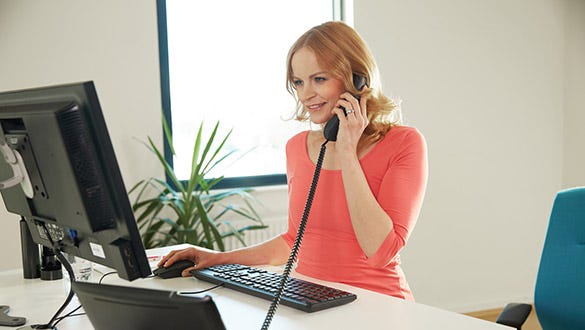

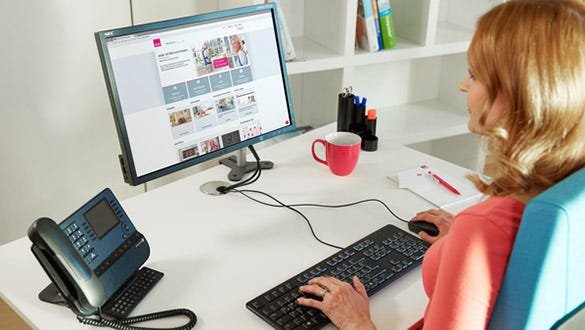

The latest statistics from the Health and Safety Executive showed that approximately 200,000 workers reported a work-related musculoskeletal disorder in 2016/2017. Due to this, the working days lost was 3.2 million days in total with an average of 16.5 days per case. But why is back pain the No. 1 widespread disease?
Mainly sedentary occupations and a lack of physical exercise in everyday life can give rise to muscular tension and back pain, even if the spine itself is healthy. Furthermore, psychological stress such as stress at work or in our private lives cause the body to become tense. As a result, our muscles harden and start to hurt. A vicious circle of stress, tension and pain.
Read the white paper to learn more about the causes of back pain and the impact of stress on the state of our backs. Because you can prevent back pain by adhering to a healthy balanced diet, taking more physical exercise and pursuing sports.
The white paper gives ten simple tips on which preventive measures are recommended and what helps against back pain. Simply download the white paper for these.
Prevention - tips for a strong back
All of us can relieve the strain on our backs in everyday life and ward off pain.
- Exercise regularly: even just three moderate training sessions of 45 minutes each per week increase our well-being, bolster the immune system and keep us fit and nimble. Gentle sports such as swimming or power walking are particularly kind to our joints.
- Healthy diet: a balanced diet keeps us fit and helps us reduce overweight and relieve strain on the back.
- Clever lifting: whenever we lift heavy objects, we should squat down and put the strain on our leg muscles instead of "putting our back into it".
- Carry properly: it is best to carry heavy objects close to the body. Avoid one-sided loading of one arm.
- Stay active: everybody who spends long hours sitting at a desk should grab every opportunity to move around – for example, climb the stairs instead of taking the lift, stand up every now and then when on the telephone or go for a walk at lunchtime.
Practical tips: Exercises to maintain a healthy back
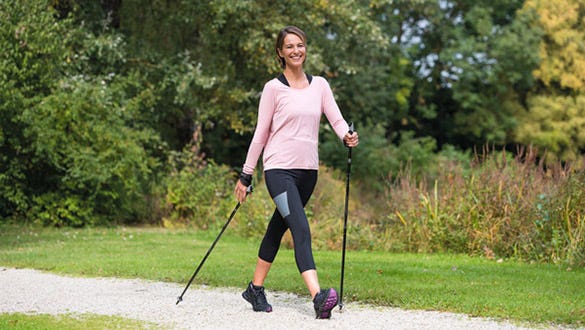

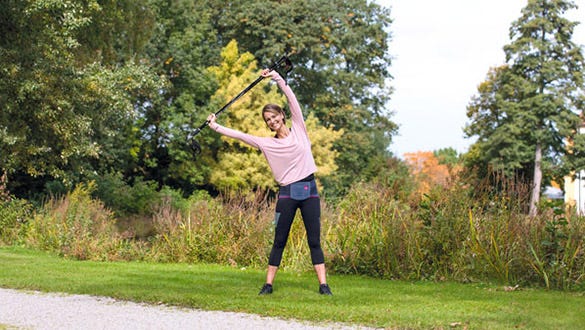

Lower back pain is estimated to affect at least 60%-80% of the population at some time in their lives.
Here’s the good news: there are back strengthening exercises and tips that you can easily integrate into your daily life.
Our guide offers you many recommendations on how you can live your life in a more back-friendly way - by moving regularly and strengthening the back muscles. Even the simplest things can have a positive effect on your back.
Try them out - your back will love you for it!
Treatment of back pain
Back pain can be treated by a variety of methods. The doctor treating you will decide whether conservative treatment (without an operation) is possible or whether surgery is needed in serious cases.
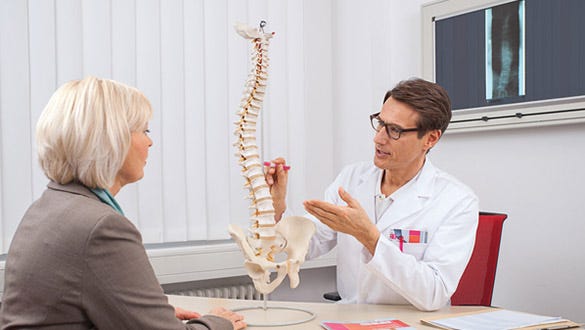

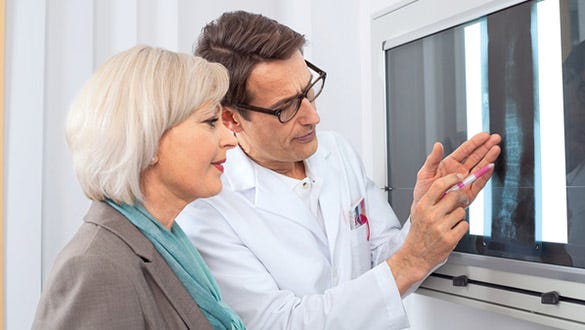

Medical devices
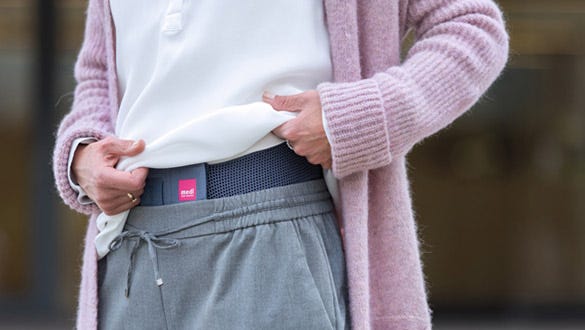

If the back hurts because of harmful physical stresses in day-to-day life or tension caused by sitting for long periods in the office, tried and tested household remedies such as buckwheat cushions or hot-water bottles will help. However, if the symptoms are permanent or keep reoccurring, another solution must be sought in the long run.
This white paper describes which medical devices are available for permanent symptoms, how they work and how they differ from one another.
Physiotherapy and Massages
During physiotherapy, special back exercises are carried out under supervision. These can mobilise the spine, relieve tension and strengthen the torso musculature.Massages, ultrasound therapy or electrotherapy can promote healing and relieve pain.
The doctor decides which exercises are most appropriate for the patient. medi's physiotherapy exercises are very suitable for many patients. For example, they help strengthen the spine and ease pain.
Medication and ointments
Medication that relieves pain and inhibits inflammation or ointments can help relieve pain in the short term. This prevents uncomfortable postural guarding.
Back pain - diagnostic investigations, prevention and treatment
Dr Holger Eggers, specialist for orthopaedics/accident surgery at the MedCenter in Bayreuth, talks about diagnostic investigations, prevention, treatment and medical devices for back pain.
Supports and braces for the back
Supports and braces are medical devices that have been developed especially for treating muscle, tendon, joint and back pain. They mould themselves perfectly to the body's contours and can relieve pain and increase mobility. Various medical devices are used depending on the nature of the condition.
Supports for the lower back can stabilise the back and relieve strain on the lumbar spine. Firmer supports, so-called braces, can straighten and stabilise the spine and provide more intensive support and relief from strain. These medical devices can compensate for physical restrictions to allow increased activity and improve the quality of life.
Products from medi
Keep moving to stay fit - the 2 x 8 of effective back exercises
Strong muscles around the spinal column protect it against wear and tear, muscular tension and pain. Back pain can be countered by regular physical exercise at a back school, with special exercises for the spine and gentle sports such as swimming or power walking.
The exercise programme has been conceived so that a complete set of exercises to strengthen and stretch your back can be completed in about 20 minutes. It would be ideal if you could go through this programme two or three times a week.
Important: please ask your doctor whether any of the exercises are unsuitable for you.
Strengthening exercises
Head nodding
Head nodding: Exercise to strengthen the neck muscles
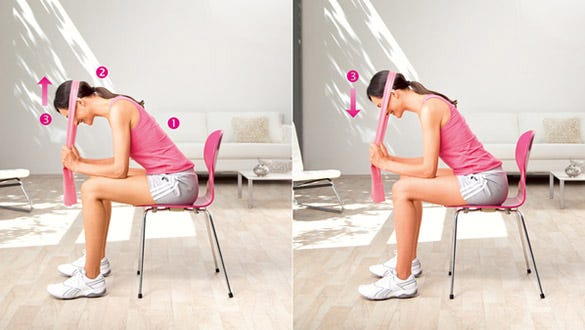

Starting position:
- Sit on a chair with your knees bent at about 90°.
- Lean forward with your upper body, keeping your back straight.
- Support your elbows on your thighs with your elbows bent at about 90°.
- Stretch the exercise band around the back of your head in front of your ears with modified tension.
- Hold the ends of the exercise band tightly with your left and right hands.
Exercise:
- Lift your head upwards with small movements against the tension of the exercise band.
Please note:
- keep your back straight
- head and neck straight
- small movements
Shoulder pulls
Shoulder pulls: Exercise to strengthen the upper back and posterior shoulder muscles
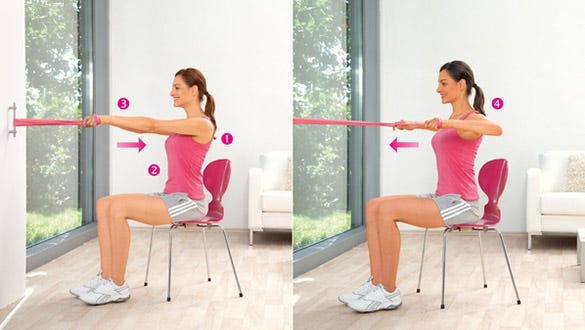

Starting position:
- Sit on a chair with your knees bent at about 90°.
- Thread the exercise band around the handle of the closed door (or alternatively around another object at door handle height that doesn‘t give way) and grasp both ends of the exercise band firmly, holding one end in each hand.
- For a firm hold, it is best if you loop the ends of the exercise band around your wrists.
- Stretch the exercise band with reasonable tension.
- Keep your arms and the exercise band in a horizontal line.
Exercise:
- Pull your elbow horizontally backwards against the tension of the exercise band, thereby moving the strap and your arms in a straight line.
Please note:
- keep your back straight
- tense your abdominal muscles!
- move the strap and your arms in a straight line
- pull your shoulder blades together (don‘t just bend your arms!)
Hip pulls
Hip pulls: Exercise to strengthen the back muscles / the large back muscle


Starting position:
- Sit on a chair with your knees bent at about 90°.
- Thread the exercise band around the handle of the closed door (or alternatively around another object at door handle height that doesn‘t give way) and grasp both ends of the exercise band firmly, holding one end in each hand.
- For a firm hold, it is best if you loop the ends of the exercise band around your wrists.
- Stretch the exercise band with modified tension.
- Keep your arms straight and pointing slightly downwards.
Exercise:
- Pull your elbows horizontally backwards close to your body against the tension of the exercise band.
- Pull your hands towards your hips.
Please note:
- keep your back straight
- tense your abdominal muscles!
- hold your elbows in tightly
- pull your hands towards your hips
Trunk bends
Trunk bends: Exercise to strengthen the lower back muscles
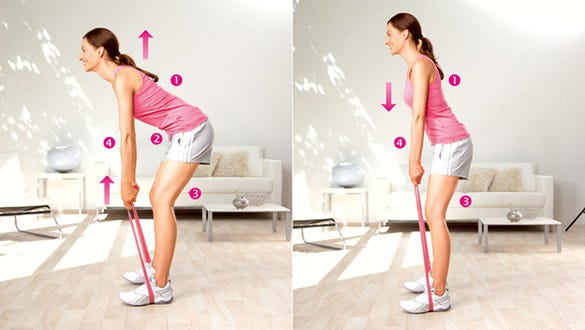

Starting position:
- Stand on a firm surface with your feet slightly apart and knees slightly bent.
- Grasp both ends of the exercise band firmly, holding one end in each hand.
- Now stand with both feet on the exercise band.
- Lean your upper body forwards with your back straight.
- Stretch the exercise band with reasonable tension.
- Keep your arms straight.
Exercise:
- Pull the exercise band vertically upwards.
- Keep your back straight and only straighten up your upper body.
- Keep your legs in the starting position, do not move them.
Please note:
- keep your back straight
- tense your abdominal muscles!
- knees slightly bent
- arms held out straight
Leg raises
Leg raises: Exercise to strengthen the buttock muscles
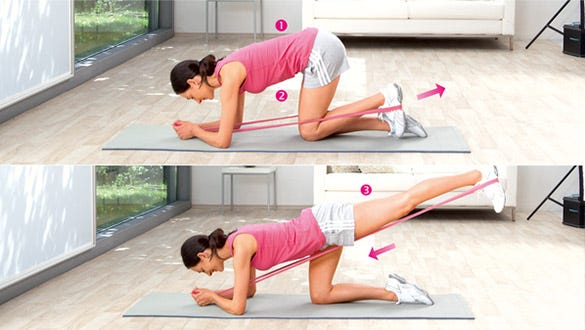

Starting position:
- Sit on a chair with your knees bent at about 90°.
- Lean forward with your upper body, keeping your back straight.
- Support your elbows on your thighs with your elbows bent at about 90°.
- Stretch the exercise band around the back of your head in front of your ears with modified tension.
- Hold the ends of the exercise band tightly with your left and right hands.
Exercise:
- Lift your head upwards with small movements against the tension of the exercise band.
Please note:
- tense your abdominal muscles!
- do not bend your upper body forwards or backwards
- keep your knees slightly bent
Side pulls
Side pulls: Exercise to strengthen the lateral trunk muscles
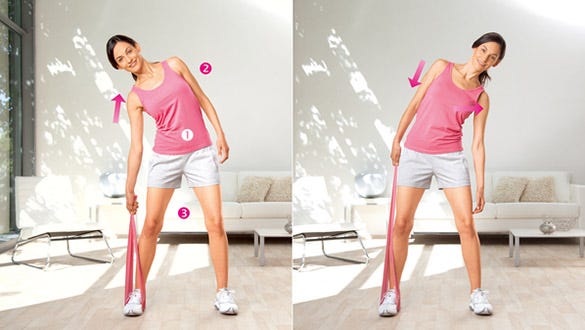

Starting position:
- Stand on a firm surface with your feet apart and knees slightly bent.
- Hold both ends of the exercise band firmly in your right hand.
- Bend your upper body to the side with your back straight.
- Now stand with your right foot in the large exercise band loop.
- Stretch the exercise band with reasonable tension.
- Keep your arms straight.
Exercise:
- Pull the exercise band vertically upwards.
- Keeping your back straight, straighten your upper body and lean over to the other side.
Please note:
- keep your back straight
- tense your abdominal muscles!
- neck, back and leg in a straight line
Sit-ups
Sit-ups: Exercise to strengthen the upper abdominal muscle
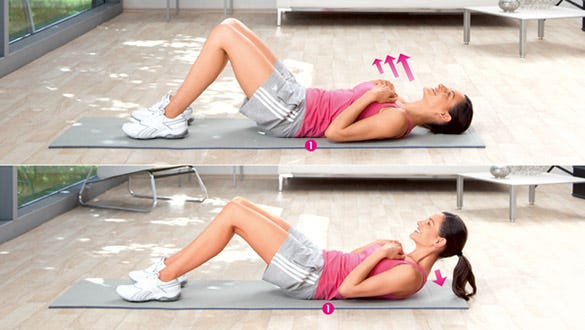

Starting position:
- Bend your knees to about 90° with your legs slightly apart.
- Press your lower back down against the floor.
- Keep your elbows by your side and your hands on your chest, not your neck.
- Rest your head on the floor.
Exercise:
- Lift your head, shoulders and chest upwards.
- Keep your lower back pressed against the floor.
Please note:
- press your lower back against the floor
Leg lifts
Leg lifts: Exercise to strengthen the lower abdominal muscles and the hip flexors
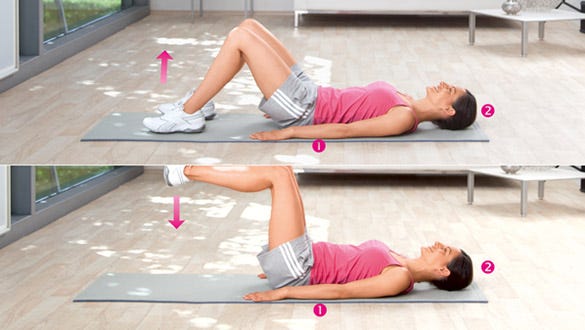

Starting position:
- Lie on your back on a firm surface.
- Bend your knees to about 90° with your legs slightly apart.
- Press your lower back down against the floor.
- Lay your arms on the floor by your body.
- Rest your head on the floor.
Exercise:
- Lift your legs up until the angle between your upper body and thighs is about 90°.
- The angle at the knee remains unchanged.
- Keep your lower back pressed against the floor.
Please note:
- press your lower back against the floor
- perhaps lay a pillow under your head
Stretching exercises
Head presses
Head presses: Exercise to stretch the neck muscles
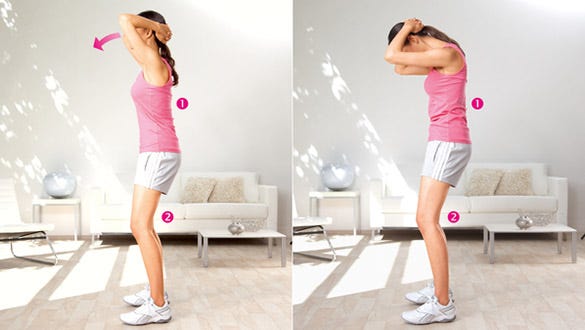

Starting position:
- Stand on a firm surface with your feet slightly apart and knees slightly bent.
- Clasp your hands together behind your head with your elbows pointing forwards.
Exercise:
- Press your head forwards with your hands.
- Keep your back straight.
- Keep your legs in the starting position, do not move them.
- You will feel the stretch in the neck muscles.
Please note:
- back straight
- knees slightly bent
Head pulls
Head pulls: Exercise to stretch the lateral neck muscles
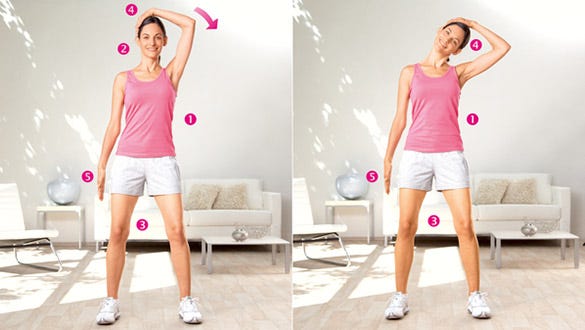

Starting position:
- Stand on a firm surface with your feet slightly apart and knees slightly bent.
- Pass your left or right hand over the top of your head and hold your head above the ear.
- Keep your arm on the same plane as the body.
Exercise:
- Pull your head over to the same side as the arm.
- Keep your back straight.
- Keep your legs in the starting position, do not move them.
- You will feel the stretch in the neck muscles.
- You can increase the stretch by pushing the other arm towards the floor.
Please note:
- keep your upper body upright
- with your head looking forwards
- knees slightly bent
- pull your head to the side with your hand
- push your other arm towards the floor
Shoulder pulls
Shoulder pulls: Exercise to stretch the upper back and shoulder muscles
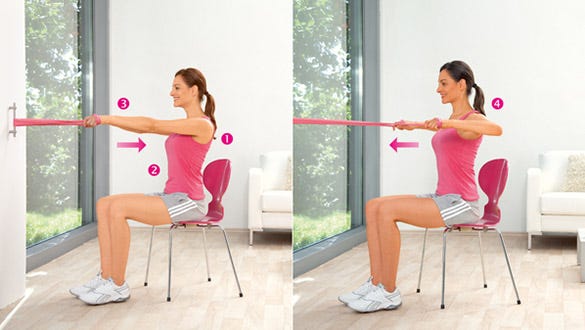

Starting position:
- Sit on a chair with your knees bent at about 90°.
- Keep your back and head straight.
- With your left hand hold the handle of a closed door (or alternatively another object at door handle heigh that doesn‘t give way).
- Grasp the wrist of the outstretched arm with your right hand.
Exercise:
- Pull your upper back / shoulder blade backwards.
- Keep your neck relaxed.
- You will feel the stretch in your back and shoulders.
- You can increase the stretch by pushing your right hand further forwards.
Please note:
- keep your back straight
- arm stretched
- pull your upper back / shoulder blade back
Trunk pulls
Trunk pulls: Exercise to stretch the lateral trunk muscles
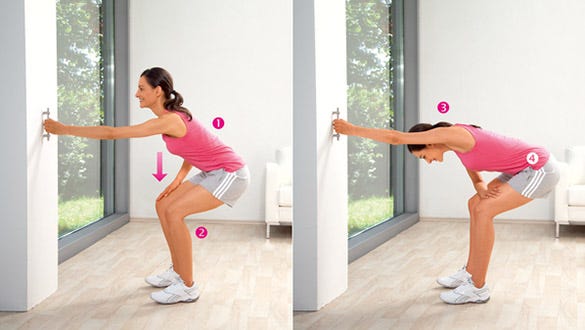

Starting position:
- Stand on a firm surface with your feet slightly apart and knees bent.
- Keep your back and head straight.
- With your left hand, hold a door handle of a closed door (or alternatively another object).
- Place your right hand or right forearm on your right thigh.
Exercise:
- Lean forward with your upper body.
- Keep your arm, neck and back in an almost straight line.
- Turn your pelvis slightly to the right and push your upper body slightly to the left (like leaning into a curve).
- You will feel the stretch running from your shoulder down your whole side to the pelvis.
Please note:
- straight back
- legs bent!
- arms, neck and back in an almost straight line
- pelvis turned slightly to the right and upper body pushed slightly to the left (like leaning into a curve)
Forward bending
Forward bending: Exercise to stretch the lower back muscles
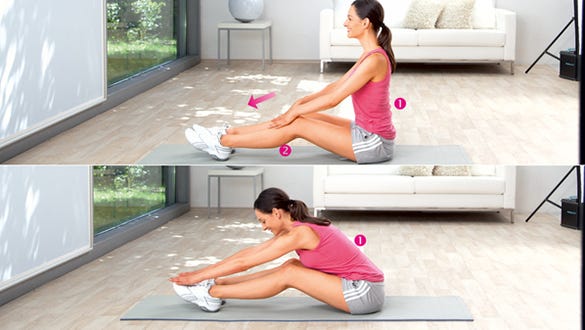

Starting position:
- Sit down on a firm surface.
- Bend your legs slightly keeping your knees a little apart.
- Keep your back, neck and head straight.
- Place your hands on your knees.
Exercise:
- Now lean forwards while keeping your back straight.
- Do not bend your neck or upper back.
- Move your stretched arms towards the tips of your toes.
- You will feel the stretch in your lower back.
Please note:
- keep your back straight when leaning forward (do not bend your neck or upper back)
- legs bent
Lower body twisting
Lower body twisting: Exercise to stretch the lower and lateral back and buttock muscles
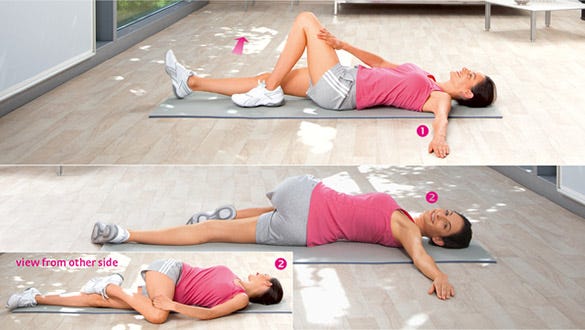

Starting position:
- Lie on your back on a firm surface.
- Straighten your right leg, bend your left leg, lay your left foot on your right knee.
- Lay your outstretched left arm on the floor, place your right hand on your left thigh.
Exercise:
- Now move the bent leg over the straight one.
- As you do so, twist your body from the chest down to the right.
- Your left arm remains the floor, your chest does not twist, your head looks in the opposite direction.
- You will feel the stretch in the lower/lateral back muscles and in your bottom.
Please note:
- arm stays on the floor
- head turns to the opposite side
Leg pulls
Leg pulls: Exercise to stretch the buttock muscles
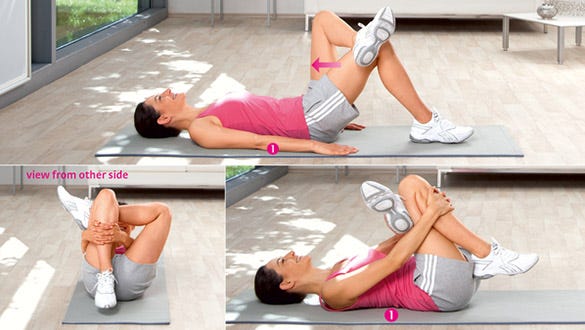

Starting position:
- Lie on your back on a firm surface, lay your arms down next to your body.
- Press your lower back down against the floor.
- Bend your right knee to an angle of about 90°.
- Bend your left knee and lay your ankle on the right leg below the knee.
Exercise:
- Now hold your right leg below the kneecap.
- Pass your left hand between both legs and grasp it with your right hand around the right leg.
- Now pull your right calf towards your face.
- You will feel the stretch in your buttock muscles.
Please note:
- press your lower back against the floor
Hip tilt
Hip tilt: Exercise to stretch the groin region and the hip flexors
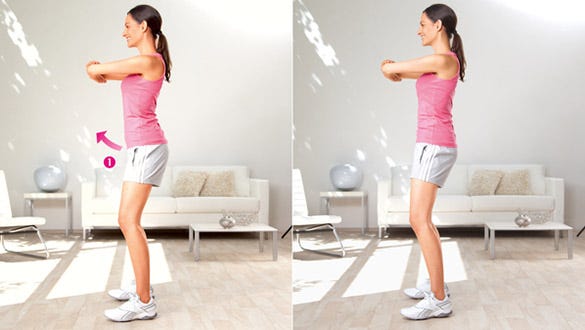

Starting position:
- Stand on a firm surface with your legs slightly apart.
- Hold your arms straight out in front of you.
Exercise:
- Keep your upper body and legs straight and tilt or push your pelvis forwards.
- You will feel the stretch in your groin.
- You can increase the stretch in your groin region by keeping your legs straight and turning your pelvis (not your upper body!) slightly further to the left or the right.
Please note:
- pelvis tilts / is pushed forwards
Fascia training
Discover the soothing effect of the specific massaging of local body regions and muscle groups. One of the aims of the myofascial release** method is to stimulate tissue circulation and thus increase tissue tone. The German Society for Osteopathic Medicine (DGOM e.V.) defines this as: all muscles are enveloped by the so-called fasciae. The fasciae themselves are connected with each other all over the body. The fasciae are stimulated by gentle pressure and tension. This improves the circulation and triggers reactions to normalise tissue tone.
Exercises you can do yourself with your BLACKROLL® MINI
You can do the exercises for myofascial release with little effort and very effectively with the BLACKROLL® MINI.
Discover the soothing effect of a specific massaging of smaller body regions and muscle groups: this relieves muscular tension and can actively support the healing process after injuries. The massage roll is so small and handy that can fit in every holdall.
Fascia training
Back
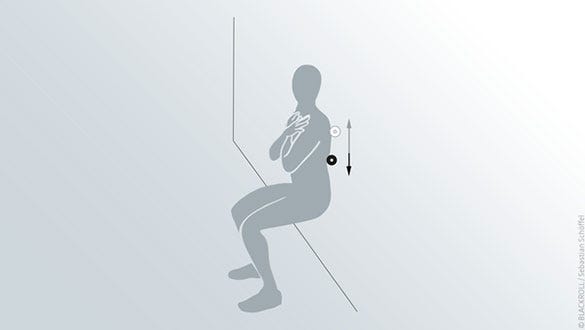

Starting position
- Stand upright
- Place the BLACKROLL® MINI between back and wall just over your hip.
Exercise
- Roll out your back in between hip and shoulder by moving up and down
- Vary with pressure by changing your balance point
Lateral trunk & latissimus
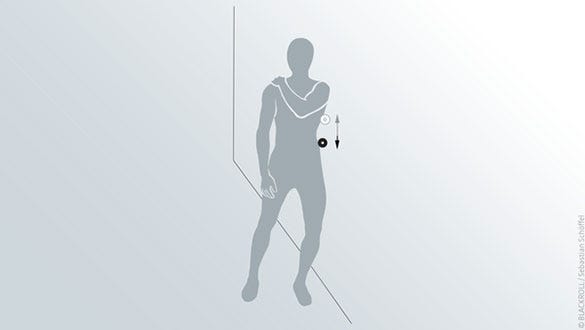

Starting position
- Stand upright
- Place one arm on the opposite shoulder
- Place the BLACKROLL® MINI between wall and thorax underneath your armpit
Exercise
- Roll out your thorax between hip and shoulder by slowly moving up and down
- Vary with pressure by working with your balance point
- When you reach the lowest point near your hip slowly get back into the initial position
- Change sides
Upper arm
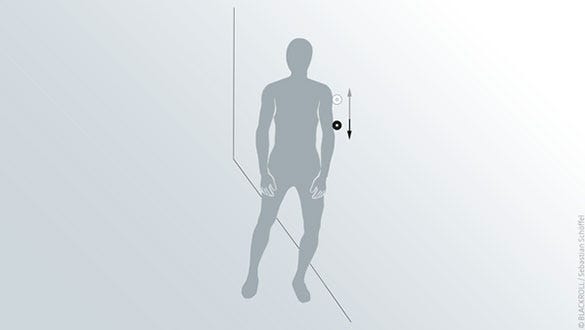

Starting position
- Stand upright
- Place the BLACKROLL® MINI between wall and upper arm near your shoulder
Exercise
- By moving up and down roll out your upper arm between elbow and shoulder
- Try changing pressure – both strength and pressure point - by working with your balance point
- When reaching the lowest point on your upper arm slowly return to the initial position
Underarms & hands
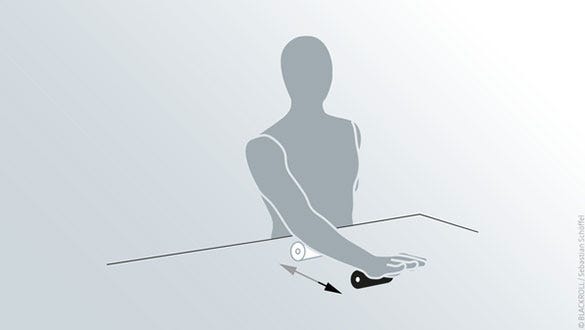

Starting position
- Sit upright at a table
- Place the BLACKROLL® MINI under your underarm close to your wrist
Exercise
- Roll out your underarm between wrist and elbow by moving back and forth on the BLACKROLL®s/sup> MINI
- When you reach your elbow slowly move back into the initial position
Plantar fascia


Starting position
- Stand upright
- Position the BLACKROLL® MINI under the sole of your foot
Exercise
- Roll back and forth with your foot on the BLACKROLL® MINI from heel to toes
- Repeat with both feet
- Apply pressure on different areas of your feet (heel, ball, right and left side) by working with your balance point on the BLACKROLL® MINI
Shin
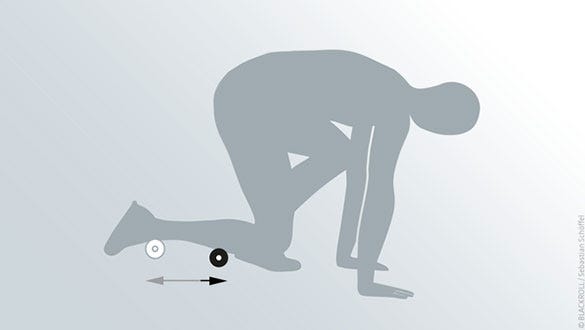

Starting position
- Get into an all-fours position
- Support yourself on your toes and lightly angled arms
- Raise your knees just a little
- Position the BLACKROLL® MINI just underneath your knee and put your right shin on it
Exercise
- Roll your shin back and forth on the BLACKROLL® MINI
- Move your leg to the left and right
- The pain should remain bearable: Choose the pressure according to this rule
- Change sides
Calf & achilles tendon
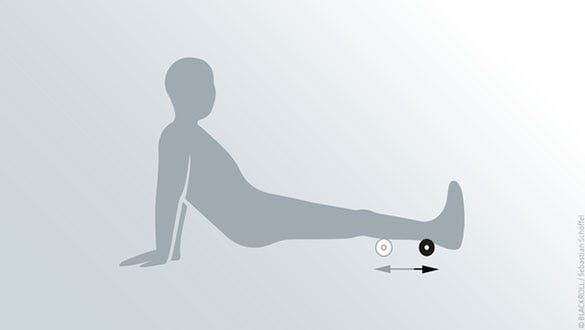

Starting position
- Sit upright on the floor supporting yourself on your hands
- Place the BLACKROLL® MINI under your right calf
- Establish your left leg next to your right knee
Exercise
- Slowly and cautiously roll out your calf
- The well established left leg helps with controlling the exercise as it supports the rolling movement and helps raising your buttocks
- To secure a full roll out of the calf slowly rotate your right leg from left to right
- Change sides
Ergonomic workplace
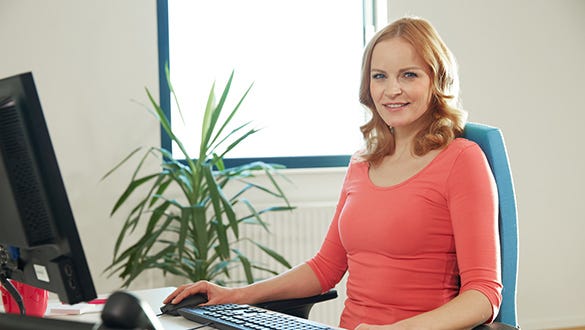

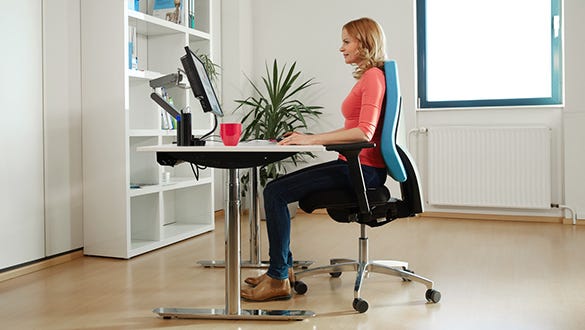

Back pain often starts at work. Sitting for hours on end or a faulty posture can strain muscles and joints and cause pain. This is especially true of jobs that require frequent bending, lifting or carrying heavy loads.
Click here to discover helpful tips and tricks from medi for a strong back in everyday working life.
Give the lower back support where it is most needed with supports and braces from medi
medi's range of supports and braces offer the right medical device for many different conditions. The products convince patients because they are comfortable to wear, are made of skin-friendly and breathable materials and are available in a wide range of sizes – so everybody can find exactly the support or brace they need. Thanks to clever details such as practical hand loops or particularly soft borders, all medi’s medical devices are easy to handle and do not cut into the skin, even when worn for long periods.
Tense, sprained or strained – the lower back is particularly often affected by pain and injuries. This is where medi's supports and braces come into their own: they can stabilise the back, relieve muscular tension and ease pain on movement. The medical devices achieve these positive effects with their multidimensional mode of action. They stabilise the lumbar spine, relieve pain and enhance mobility. This can prevent further loss of muscle mass, so-called "muscle atrophy".
Guide to back treatment
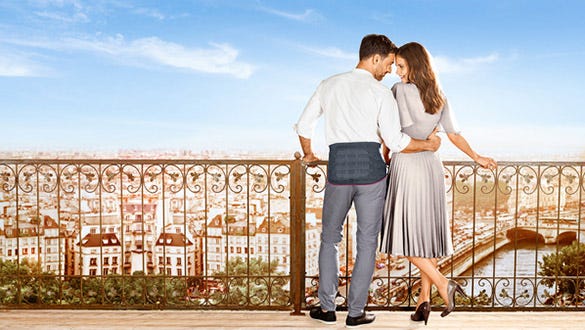



Back ache often has many different causes: most people (approx. 85% of all cases) have so-called non-specific lower back pain, in which several different causes lead to back pain. These can be overstrain, contracture or dysfunction of ligaments, muscles, facet joints and intervertebral discs.
Here's how to get your back fit again: There are many simple exercises for keeping the back fit or even strengthening it. This guide describes these clearly and with many pictures. You can keep all the parts of your back fit and healthy with eight strengthening and eight stretching exercises. The guide is rounded off with a chapter on the causes of back pain and a chapter on helpful supports and braces from medi.
Stylish with an orthosis - the practical style guide


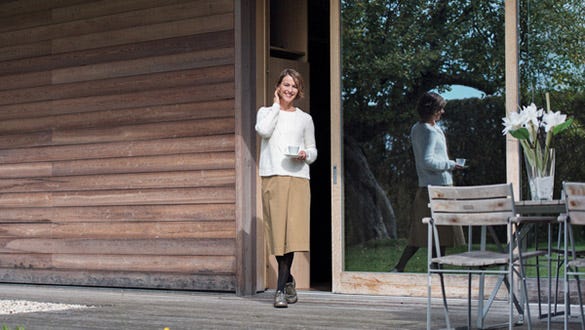

Do you regularly wear a back orthosis but do not want to forsake your style?
You don’t have to.
Our style guide shows you how you can combine your orthosis with a wide variety of trends and looks. We will also show you practical tips on how you can conceal any problem areas and show off your figure - even wearing a back orthosis! Let us inspire you!
More information
* Klein, Dr Christoph (2014): Orthopaedics for patients. Understanding medicine. Remagen: Published Michels-Klein, p. 277.
** The word "myofascial" stems from "myo" for muscles and "fascial" for fasciae. Doctors define fasciae as connective tissue structures that surround our muscles and organs.

